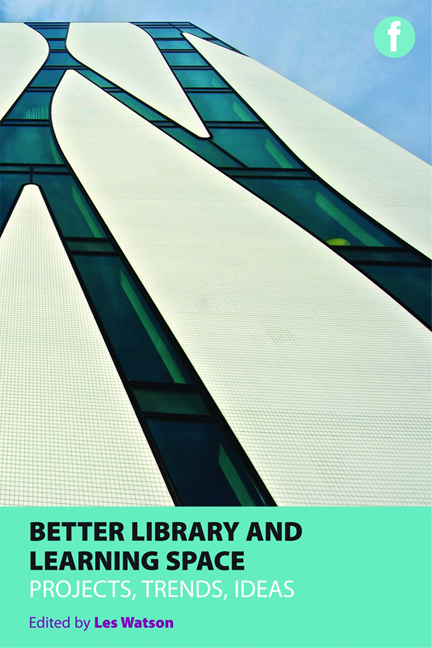Book contents
- Frontmatter
- Contents
- Case studies
- Acknowledgements
- Contributors
- Introduction – about this book
- PART 1 PROJECTS AND TRENDS
- PART 2 TRENDS AND IDEAS
- Introduction
- 7 Library space and technology
- 8 Library space and learning
- 9 Key ideas on space
- 10 Thinking it through
- Summary to Part 2
- PART 3 IDEAS AND FUTURES
- Index
9 - Key ideas on space
from PART 2 - TRENDS AND IDEAS
Published online by Cambridge University Press: 08 June 2018
- Frontmatter
- Contents
- Case studies
- Acknowledgements
- Contributors
- Introduction – about this book
- PART 1 PROJECTS AND TRENDS
- PART 2 TRENDS AND IDEAS
- Introduction
- 7 Library space and technology
- 8 Library space and learning
- 9 Key ideas on space
- 10 Thinking it through
- Summary to Part 2
- PART 3 IDEAS AND FUTURES
- Index
Summary
Introduction
In a chapter entitled ‘Key ideas on space’ you might expect to read about the many tangible factors to be taken into consideration in creating a new or refurbished library or learning space. Factors such as lighting, noise control, IT infrastructure, ventilation, temperature control, humidity and maintenance among many others all have to be considered and have to be right – they are often the source of complaint by users if they are not right, and occasionally even if they are. The professionals such as architects and building engineers engaged in the project will provide expert guidance on these tangible aspects and sources such as the Space Management Group (smg.ac.uk), in the UK, can provide library and learning staff with sufficient background, toolkits and guidance to enable them to participate in the consideration of these factors.
Hugh Anderson and I (Watson and Anderson, 2008) working on a project for Jisc carried out a survey of a number of further and higher education institutions to identify which of these tangible factors proved to be most problematic. By a clear margin heating and ventilation caused the most issues for the spaces in our survey, closely followed by noise. Many libraries and learning spaces are felt by users to be too hot in the summer and too cold in the winter, and users of the space often complain about the lack of local control that they have over heating and ventilation. Ensuring that temperature and ventilation controls are rigorously modelled is an absolutely essential prerequisite to project success, which must be undertaken in the planning stage of the project. Issues around noise were also often mentioned to us in our survey, particularly relating to large open plan spaces, but in spaces where strategies such as zoning and semi-private structures (see pages 125 and 126) were deployed noise was not an issue.
Among the factors that were felt to be less problematic were lighting and smells. While it appeared from the survey that there was a general satisfaction with lighting arrangements, our feeling was that opportunities were being missed to introduce additional impact into a space by using lighting, which could add interest and also provide an easily manageable way of introducing colour flexibility – a key factor in determining mood, which can also send subtle signals about the purpose of a space.
- Type
- Chapter
- Information
- Better Library and Learning SpaceProjects, trends and ideas, pp. 117 - 130Publisher: FacetPrint publication year: 2013

